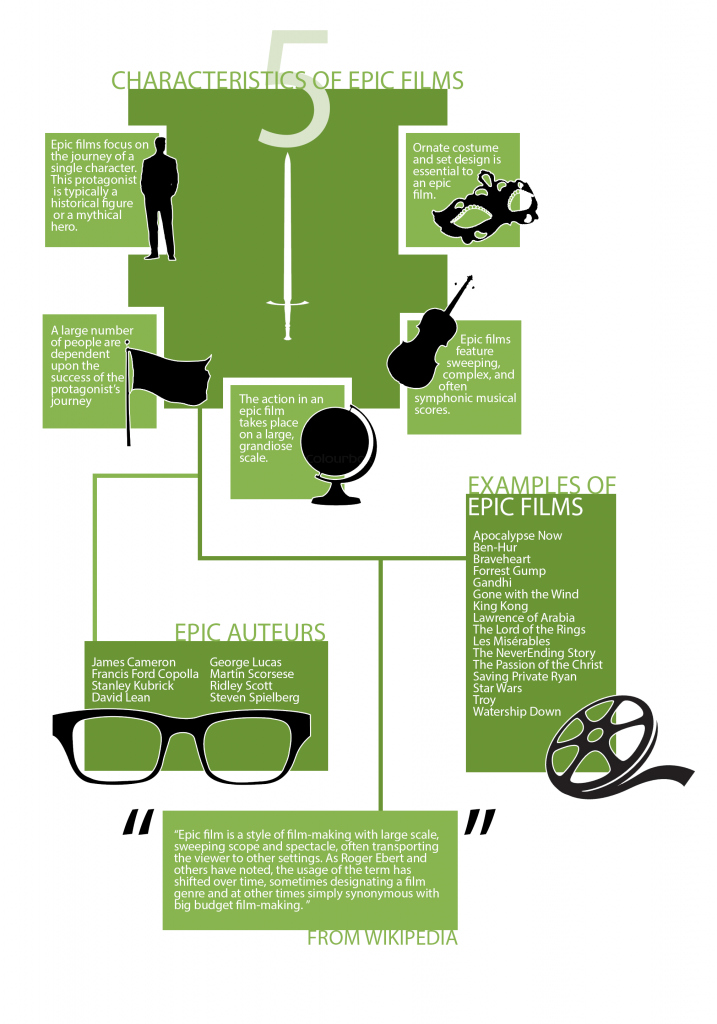Assignment #2
 Epic films focus on the journey of a single character. This protagonist is typically a historical figure or a mythical hero.
Epic films focus on the journey of a single character. This protagonist is typically a historical figure or a mythical hero.
- In Star Wars: A New Hope, the focus is on Luke Skywalker and his journey from farm boy to galactic savior. His path conforms to the archetypical hero’s journey.
- Braveheart follows the Scottish folk hero William Wallace in his quest to free Scotland from England and its tyrannical King, Edward I. His journey epitomizes the traditional epic character’s journey as he is the center of a story, and is a historical figure, although sometimes even mythicized to some extent.
- In 2001: A Space Odyssey, a movie in four “acts,” Dr. David Bowman is one leader of the spaceship Discovery One on its voyage to Jupiter to purportedly investigate the presence of a mysterious black monolith. In a twist on the classic epic, he does not have an elaborate backstory; the character’s backstory is instead more abstractly represented in the first act, The Dawn of Man, and, in light of the film’s equally abstract conclusion, we can understand him to be a hero representative of all of humankind.
A large number of people—often entire societies—are dependent upon the success of the protagonist’s journey in an epic film.
- In Star Wars: A New Hope, much of the galaxy is dependent on Luke Skywalker’s journey. Only through his success can they be freed from the inhumane, tyrannical rule of the Galactic Empire.
- Not only are the Scottish soldiers dependent on their leader’s bravery and success, but all of Scotland’s freedom rides on his success in defeating the English. If it weren’t for Wallace, the English would likely have continued to rule Scotland by bribing its rulers with money and land.
- In a ship of state metaphor, Dr. David Bowman becomes the only human survivor in the film after HAL (the spaceship’s computer) kills his co-captain and other cryogenically hibernating crew members. When he tries and fails to save his co-pilot Dr. Frank Poole, he manages to dismantle the computer’s brain and direct a pod to complete the mission to Jupiter.
The action in an epic film takes place on a large, grandiose scale.
- The action in Star Wars: A New Hope consists of grand dogfights in space, the destruction of entire planets, and an attempt to destroy a space station the size of a small moon.
- The multiple battle scenes in Braveheart are certainly “large” and “grandiose” as Wallace gives numerous famous war speeches and rallies his disheartened soldiers to charge the English armies. Furthermore, it is made clear that the English vastly outnumbered the Scottish in almost all of these battles, which made the battle scenes all the more dramatic as Wallace and his armies were always playing the role of the underdog.
- From vicious fights among our hominid ancestors to the extended battle between Discovery One’s computer (HAL) and David, the action in 2001: A Space Odyssey is epic in a celestial-scale, oniric way.
Epic films feature sweeping, complex, and often symphonic musical scores.
- The score of Star Wars: A New Hope was conducted by John Williams and performed by the London Symphony Orchestra. It is one of the most memorable sound tracks and film history, making use of leitmotif–the anchoring of characters, places, and plot points to reoccurring melodic phrases.
- The musical score, done almost exclusively by James Horner, who has done the music for a number of other epic films such as Titanic and Apollo 13, is especially grand in that it revolves a lot around traditional Scottish music. With bagpipes being one of the most prevalent instruments incorporated in the epic soundtrack, Horner always seems to find the perfect sound for both the romance as well as battle scenes throughout the film.
- Stanley Kubrick’s 2oo1: A Space Odyssey features one of the most recognizable movie scores, especially the opening theme from Richard Strauss’ Also sprach Zarathustra and the classical waltz “Blue Danube.” There is little dialogue in the film overall, and the grandiose, psychedelic visuals are memorably complemented and enhanced by sweeping classical scores and drawn out, creepy synthesized pieces of music.
Ornate costume and set design is essential to an epic film.
- The costumes in Star Wars: A New Hope include the elaborate full-body suits of Darth Vader and his Stormtroopers and a wide variety of suits, masks, and make-up for the various aliens. The sets include grand scenes in space, an elaborate dessert town, and the interiors of spaceships and space stations.
- Costume design is also extremely elaborate in Braveheart. From the kilts of the Scottish warriors, to the chainmail armor of the English, to the intricate war paint of William Wallace and his comrades, the costumes perfectly represent the time period. Primarily being filmed in the fields and mountains of Scotland and Ireland, the sets are not only grandiose and beautiful, but are also about as accurate as a set can be given that the actual battles portrayed in the film took place in the same place only a few hundred years ago.
- As a sci-fi cinematic representation of the not-so-distant future (it was made in 1968), the overall aesthetic of 2001: A Space Odyssey is at once complex and almost minimalist, in a very polished way. There are few sets in the film, which makes their set design even more significant. The doughnut-shaped “centrifuge” main control room of the Discovery One, spacesuits, hominid costumes, ornate bedroom on Jupiter, and even the design of the computer interface was very closely managed by Kubrick. The use of novel special effects is also stunning for when the film was made, notably the psychedelic stargate sequence as our hero enters Jupiter.

